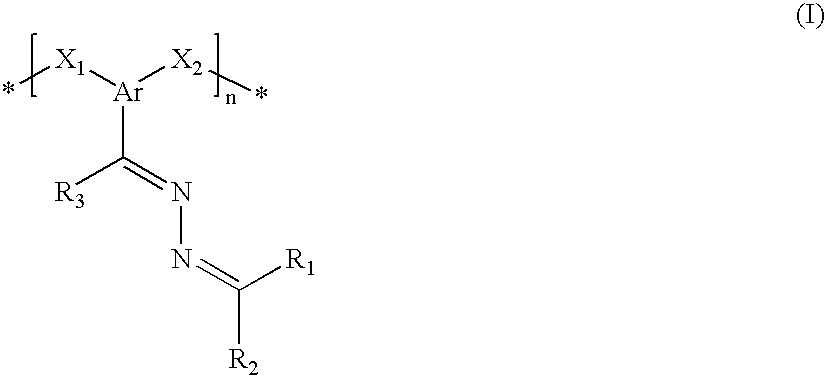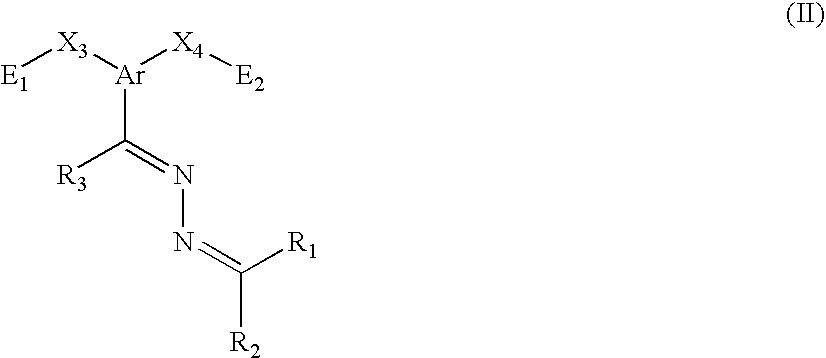Poly(azine)-based charge transport materials
a charge transport and polyazine technology, applied in the field of organophotoreceptors, can solve problems such as detriment to the performance of organophotoreceptors, and achieve the effects of good chemical effect, high quality of imaging system, and high quality of imag
- Summary
- Abstract
- Description
- Claims
- Application Information
AI Technical Summary
Benefits of technology
Problems solved by technology
Method used
Image
Examples
example 1
Synthesis and Characterization Charge Transport Materials
[0100] This example describes the synthesis and characterization of Compound (1). The characterization involves chemical characterization of the compound. The electrostatic characterization, such as mobility and ionization potential, of the materials formed with the compound is presented in a subsequent example.
Bis(4,4′-diethylamino)benzophenone Hydrazone
[0101] A solution of bis(4,4′-diethylamino)benzophenone (108.1 g, 0.335 mol, from Aldrich), hydrazine monohydrate (98%, 244 ml, 5 mol, from Aldrich), and 10 ml of concentrated hydrochloric acid (from Aldrich) in 250 ml of 2-propanol was added to a 1000 ml 3-neck round bottom flask equipped with a reflux condenser and a mechanical stirrer. The solution was refluxed for approximately 6 hours with an intensive stirring until bis(4,4′-diethylamino)benzophenone disappeared. The solution was allowed to stand overnight. The crystals that formed upon standing were removed by filtr...
example 2
Charge Mobility Measurements
[0105] This example describes the measurement of charge mobility and ionization potential for charge transport materials, specifically Compound (1) above.
Sample 1
[0106] A mixture of 0.1 g of the Compound (1) and 0.1 g of polycarbonate Z was dissolved in 2 ml of tetrahydrofuran. The solution was coated on a polyester film with a conductive aluminum layer by a dip roller. After the coating was dried for 1 hour at 80° C., a clear 10 μm thick layer was formed. The hole mobility of the sample was measured and the results are presented in Table 1.
Mobility Measurements
[0107] Each sample was corona charged positively up to a surface potential U and illuminated with 2 ns long nitrogen laser light pulse. The hole mobility μ was determined as described in Kalade et al., “Investigation of charge carrier transfer in electrophotographic layers of chalkogenide glasses,” Proceeding IPCS 1994: The Physics and Chemistry of Imaging Systems, Rochester, N.Y., pp. 747-7...
example 3
Ionization Potential Measurements
[0109] This example describes the measurement of the ionization potential for the charge transport material described in Example 1.
[0110] To perform the ionization potential measurements, a thin layer of charge transport material about 0.5 μm thickness was coated from a solution of 2 mg of charge transport material in 0.2 ml of tetrahydrofuran on a 20 cm2 substrate surface. The substrate was an aluminized polyester film coated with a 0.4 μm thick methylcellulose sub-layer.
[0111] Ionization potential was measured as described in Grigalevicius et al., “3,6-Di(N-diphenylamino)-9-phenylcarbazole and its methyl-substituted derivative as novel hole-transporting amorphous molecular materials,” Synthetic Metals 128 (2002), p. 127-131, incorporated herein by reference. In particular, each sample was illuminated with monochromatic light from the quartz monochromator with a deuterium lamp source. The power of the incident light beam was 2-5·10−8 W. A negativ...
PUM
| Property | Measurement | Unit |
|---|---|---|
| thickness | aaaaa | aaaaa |
| thickness | aaaaa | aaaaa |
| thickness | aaaaa | aaaaa |
Abstract
Description
Claims
Application Information
 Login to View More
Login to View More - R&D
- Intellectual Property
- Life Sciences
- Materials
- Tech Scout
- Unparalleled Data Quality
- Higher Quality Content
- 60% Fewer Hallucinations
Browse by: Latest US Patents, China's latest patents, Technical Efficacy Thesaurus, Application Domain, Technology Topic, Popular Technical Reports.
© 2025 PatSnap. All rights reserved.Legal|Privacy policy|Modern Slavery Act Transparency Statement|Sitemap|About US| Contact US: help@patsnap.com



